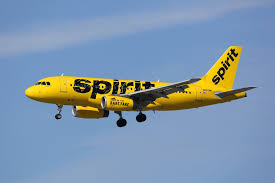
| Budget carrier warns of substantial doubt about continuing operations amid weakening demand | Spirit Airlines is facing its most challenging period since emerging from bankruptcy, with the budget carrier issuing a stark warning about its ability to continue operating as travelers dramatically reduce their flight bookings in response to economic uncertainty.
The airline, known for its ultra-low-cost model and no-frills approach to air travel, has admitted to having substantial doubt about its survival prospects. This alarming development comes just months after the company successfully emerged from Chapter 11 bankruptcy protection in March, having eliminated $800 million in debt during the restructuring process.
The perfect storm hitting Spirit
Multiple factors have converged to create what industry experts describe as a perfect storm for the budget airline. The most significant challenge stems from weakening consumer demand, with travelers cutting back on flights following President Trump’s announcement of new tariffs that have created economic uncertainty across various sectors.
This demand reduction has hit Spirit particularly hard because the airline relies heavily on leisure travelers who are more sensitive to economic pressures than business passengers. When families and vacation travelers tighten their budgets, discount airlines like Spirit typically feel the impact first and most severely.
The company’s financial struggles are reflected in its second-quarter results, which showed a net loss of $245.8 million for the period ending June 30. This represents a significant deterioration from the previous year’s loss of $192.9 million during the same quarter, highlighting the accelerating nature of the airline’s challenges.
Desperate measures for cash generation
To address its mounting financial pressures, Spirit is considering selling aircraft and airport gate rights to raise much-needed capital. These assets would serve as collateral to meet debt obligations and credit-card processor requirements that are essential for continued operations.
The potential sale of aircraft represents a particularly concerning development, as it would reduce Spirit’s operational capacity and limit its ability to generate revenue through flight operations. Airlines typically view their aircraft fleets as core assets that generate long-term income, making such sales a sign of severe financial distress.
Airport gate rights are similarly valuable assets that provide airlines with access to prime terminal locations. Selling these rights could force Spirit to operate from less convenient locations, potentially making the airline less attractive to passengers and further damaging its competitive position.
The bankruptcy aftermath complications
Spirit’s current crisis is particularly striking given the company’s recent emergence from bankruptcy protection. During the Chapter 11 process, the airline had projected a $252 million profit for 2025 in court filings submitted last December, painting an optimistic picture of its post-bankruptcy prospects.
The dramatic shift from projected profitability to survival concerns in less than a year underscores how quickly conditions can deteriorate in the volatile airline industry. It also raises questions about the accuracy of the financial projections that formed the basis of the airline’s bankruptcy exit strategy.
The bankruptcy restructuring process typically involves extensive financial analysis and planning designed to ensure a company’s long-term viability. Spirit’s rapid return to financial distress suggests that either market conditions changed more dramatically than anticipated or the original recovery projections were overly optimistic.
Market reaction and investor concerns
Wall Street has responded negatively to Spirit’s survival warnings, with shares falling 6.8% in premarket trading to $3.30 following the announcement. This decline reflects investor skepticism about the airline’s ability to navigate its current challenges without additional restructuring or external intervention.
The stock’s poor performance also indicates broader market concerns about the budget airline sector’s vulnerability to economic downturns. Discount carriers often struggle more than traditional airlines during difficult periods because they have fewer resources and less operational flexibility.
Industry implications and passenger impact
Spirit’s struggles have broader implications for the airline industry, particularly in the ultra-low-cost carrier segment. The company has been a significant player in making air travel more accessible to price-sensitive consumers, and its potential failure could reduce competition and increase fares across the industry.
For passengers who have purchased tickets on Spirit flights, the survival warnings raise concerns about potential service disruptions or cancellations. While the airline continues operating normally for now, travelers may want to consider backup plans or travel insurance to protect against potential disruptions.
The company’s challenges also highlight the ongoing volatility in the travel industry, which continues to face headwinds from economic uncertainty, changing consumer behavior, and operational pressures that have persisted since the pandemic recovery period.
Spirit’s situation serves as a reminder of how quickly airline fortunes can change and the importance of financial stability in an industry known for its cyclical nature and sensitivity to external economic factors.
Source:
